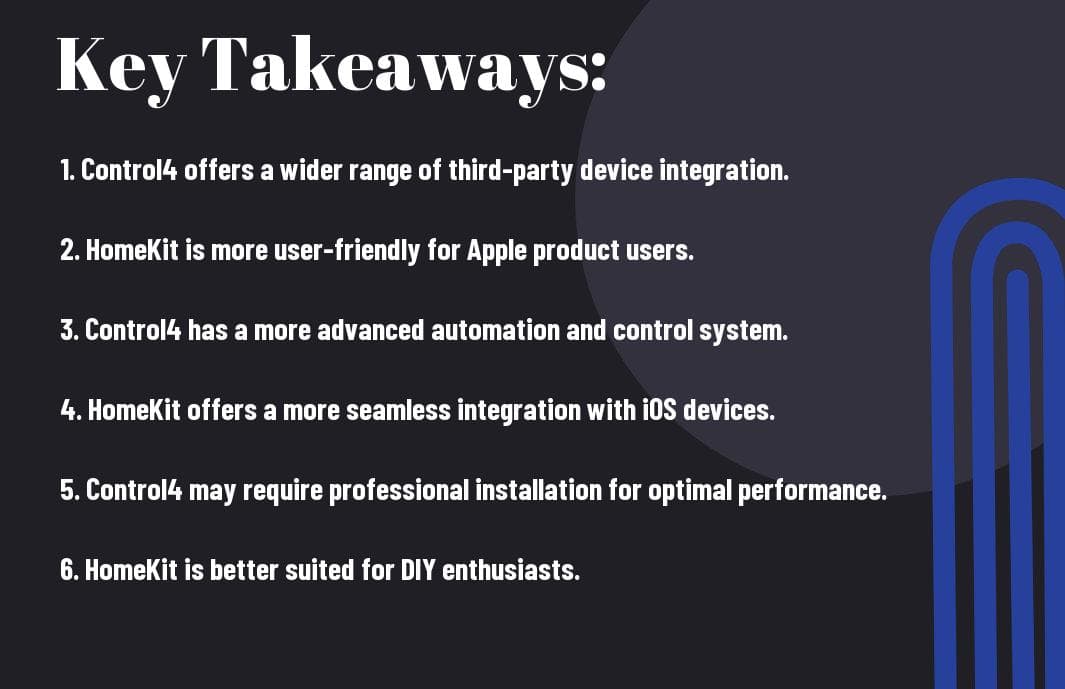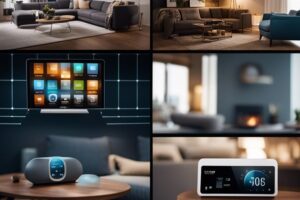Examine the crucial details of Smart Home Ecosystems, specifically the compatibility of Control4 and HomeKit, and learn which one suits your needs best. When it comes to integrating various smart home devices, the compatibility of your chosen ecosystem is essential for a seamless and hassle-free experience. In this blog post, you will gain a comprehensive understanding of the key differences between Control4 and HomeKit, allowing you to make an informed decision that is tailored to your specific smart home requirements.
Key Takeaways:
- Control4 offers a comprehensive smart home ecosystem with its extensive range of compatible devices and seamless integration, allowing users to automate and control various aspects of their homes.
- HomeKit Compatibility provides a more streamlined and user-friendly smart home experience for Apple users, offering a wide range of device compatibility and intuitive control through the Apple ecosystem.
- Ultimately, the choice between Control4 and HomeKit Compatibility depends on individual preferences and existing device ecosystems, with Control4 catering to a more diverse range of devices and HomeKit appealing to Apple users for its seamless integration and ease of use.

Key Components and Compatibility
When it comes to building a smart home ecosystem, it’s important to understand the key components and their compatibility with your chosen platform. Let’s take a closer look at the Control4 and HomeKit ecosystems and how they handle various devices and features.
Control4 Configuration and Tools
Control4 provides a comprehensive set of tools and configurations to control and manage various smart home devices. Using the Composer Pro software, you can customise your automation, create schedules, and manage different settings for your smart home devices. The Control4 system allows you to integrate a wide range of third-party smart home products, offering you the flexibility to design a customised smart home experience tailored to your specific needs.
control4.configureDevice(deviceID, settings);
control4.createSchedule(deviceID, schedule);
control4.manageSettings(deviceID, customSettings);
HomeKit Features and Supported Devices
Apple’s HomeKit platform emphasises security and simplicity, offering a wide range of compatible smart home devices. With HomeKit, you can easily control and manage your smart home devices using the Apple Home app or Siri voice commands. HomeKit also supports advanced features such as automation, scenes, and triggers, empowering you to create a seamless smart home experience. The HomeKit ecosystem supports a variety of devices including lights, locks, cameras, and thermostats, ensuring that you can find the perfect devices to fit your lifestyle.
homeKit.controlDevice(deviceID, action);
homeKit.createScene(sceneName, devices);
homeKit.setAutomation(trigger, action);
Setting Up and Optimizing Your Smart Home
When setting up your smart home ecosystem, it’s crucial to consider compatibility between different devices and platforms. If you’re using Control4 or HomeKit, you’ll want to ensure seamless integration for a smooth and efficient home automation experience. Here’s how you can optimize your smart home setup for Control4 vs HomeKit compatibility.
Best Practices for Smart Home Configuration
One of the best practices for configuring your smart home is to ensure that all devices and systems are compatible with your chosen ecosystem. You can check compatibility by referring to the manufacturer’s specifications or using online resources such as our guide on Will Control4 work with Apple HomeKit? before purchasing any new devices. Additionally, it’s essential to plan out your smart home’s layout and design to ensure optimal connectivity and coverage for your devices.
// Example of checking device compatibility
const device = 'Control4 Smart Thermostat';
const compatibleWithHomeKit = checkCompatibility(device, 'HomeKit');
Analyzing and Testing for Optimal Performance
Once you have set up your smart home devices, it’s important to analyze and test the system for optimal performance. You can do this by monitoring the responsiveness and reliability of your devices, as well as their integration with the Control4 or HomeKit platform. Regularly testing and updating your smart home setup can help identify any issues or areas for improvement, ensuring that you have a seamless and efficient home automation experience.
// Example of testing smart home performance
function testSmartHomePerformance() {
const performance = analyzePerformance(yourSmartHomeSystem);
if (performance.issues) {
optimizePerformance(performance.issues);
}
}
Advanced Integration
When it comes to advanced integration, both Control4 and HomeKit offer a range of possibilities. Let’s take a closer look at the options available for integrating your smart home devices with these ecosystems.
Scripting for Enhanced Functionality
If you want to take your smart home to the next level, scripting can be incredibly useful. With Control4, you have the ability to create custom scripts using Composer Pro, which allows you to personalize your home automation to suit your specific needs. For example, you can create a script that adjusts the lighting, temperature, and music in your living room all at once with a single command. Here’s an example of a simple lighting control script in Composer Pro:
When LivingRoom_MotionSensor detects movement:
LivingRoom_Lights brighten to 80%
Mistakes to Avoid in Smart Home Integration
While integrating smart home devices can bring a lot of convenience and efficiency to your life, there are also mistakes that you should avoid to ensure a smooth experience. One common mistake is not properly securing your smart home devices, which can leave you vulnerable to cybersecurity threats. It’s important to regularly update the firmware on your devices and use strong, unique passwords to prevent unauthorized access. Additionally, be cautious when granting permissions to third-party applications, as they could potentially compromise the security of your smart home ecosystem. Always verify the credibility of the apps and services you integrate with your system.
# Set strong, unique passwords for all smart home devices
# Regularly update firmware on all devices
# Verify the credibility of third-party applications before granting permissions
Comparison and Analysis
When it comes to choosing a smart home ecosystem, it’s important to weigh the compatibility and features of different platforms. In this section, we’ll compare and analyse the Control4 and HomeKit ecosystems to help you make an informed decision.
First, let’s take a look at the discussion on Control4 vs Apple Homekit : r/homeautomation to understand the community’s perspective on this topic.
Control4 vs HomeKit: Pros and Cons
When considering Control4 and HomeKit, it’s essential to weigh the pros and cons of each system. Here’s a breakdown to help you assess their suitability for your smart home setup.
Control4
HomeKit
Offers professional installation and customization
Seamless integration with Apple devices
Wide range of compatible devices
User-friendly interface
Advanced automation capabilities
High level of security and data privacy
Requires professional installation
Limited device compatibility
Higher upfront costs
Dependent on Apple ecosystem
Final Recommendations on Ecosystem Selection
Considering the pros and cons of both Control4 and HomeKit, it’s important to evaluate your specific needs and preferences. If you prioritise professional installation and a wide range of compatible devices, Control4 may be the right choice for you. On the other hand, if seamless integration with Apple devices and a user-friendly interface are your top priorities, HomeKit could be the ideal option. Ultimately, the decision should be based on your unique requirements and the devices you intend to integrate into your smart home.
Conclusion
So, when deciding between Control4 and HomeKit compatibility for your smart home ecosystem, it’s important to consider your specific needs and preferences. Control4 offers a more comprehensive and customisable platform, with a wide range of compatible devices and seamless integration. On the other hand, HomeKit is a more user-friendly and accessible option, especially for those already invested in the Apple ecosystem. Ultimately, the decision comes down to what works best for you and your home automation needs.
Smart Home Ecosystems – Control4 vs HomeKit Compatibility
Q: What is a Smart Home Ecosystem?
A: A smart home ecosystem is a network of interconnected smart devices and appliances that can be controlled remotely and work together to automate various aspects of a home, such as lighting, heating, security, and entertainment.
Q: What is Control4?
A: Control4 is a leading provider of home automation systems that enable users to control and automate their smart home devices through a single platform.
Q: What is HomeKit?
A: HomeKit is Apple’s smart home platform that allows users to control and automate their compatible smart home devices using their iPhone, iPad, or Apple Watch.
Q: Are Control4 and HomeKit compatible with each other?
A: Control4 and HomeKit are not directly compatible with each other, as they are separate smart home ecosystems with different protocols and technologies.
Q: Can I use Control4 and HomeKit together in my smart home?
A: Yes, it is possible to integrate Control4 and HomeKit in a smart home setup using a variety of third-party solutions and workarounds, such as home automation bridges and hubs.
Q: What are the advantages of using Control4 in a smart home ecosystem?
A: Control4 offers extensive support for a wide range of smart home devices and provides advanced automation and customisation capabilities, making it a powerful choice for creating a comprehensive smart home ecosystem.
Q: What are the advantages of using HomeKit in a smart home ecosystem?
A: HomeKit offers seamless integration with Apple devices, strong emphasis on privacy and security, and a user-friendly interface, making it an appealing choice for Apple users looking to build a smart home ecosystem.








